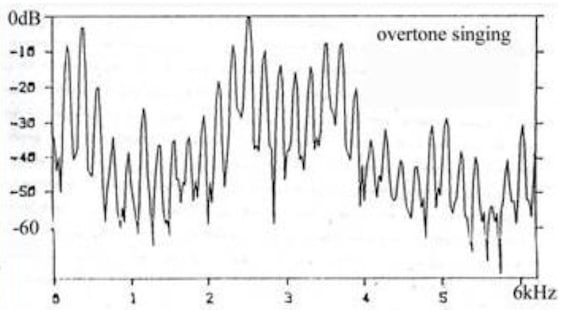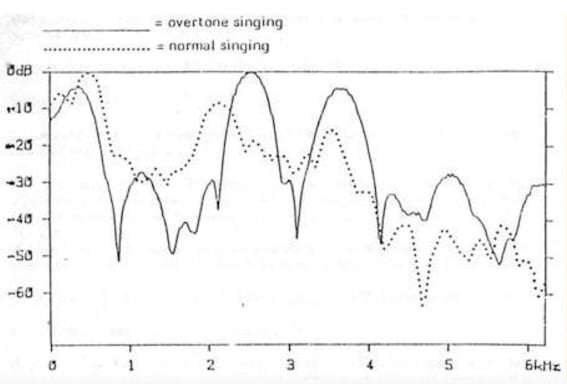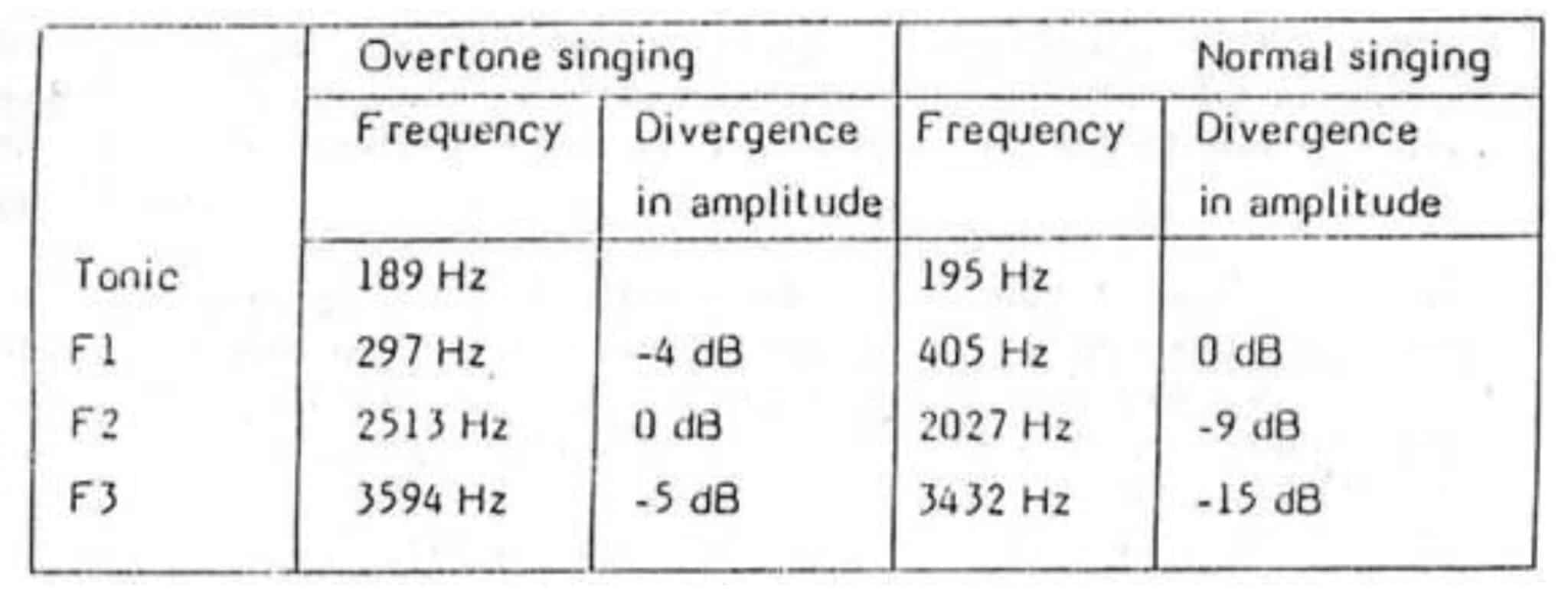A Two Voiced Song With No Words
by Lauri Harvilahti
circa 1981
Overtone singing, which is often referred to as biphonic or pharyngeal singing, is a style of singing within the framework of which it is possible to produce two (sometimes three) tones which are distinct auditory experiences (1). Singing in this style involves having the vocal cords produce a low tonic which is then normally used in the same manner as a pedal point. Utilising a specific technique a voice based on the same series of overtones is also produced. Altering the shape of the oral cavity by movements of the tongue, the singer is able to shift from one overtone to another and thus present melodies(2). The area which can be profitably exploited extends from the 5th to the 13th harmonic.
Upon first acquaintance, this type of singing leaves a striking impression; nevertheless it is known to several peoples of Central Asia as the Tuvins, the Mongols, Khakas, the Bashkirs, and the Tibetans. According to A. N. Aksenov, Tuva is the focal area of overtone singing. The Tuvins know four different types of singing, each of which has its own name: kargyraa, borbannadyr, sygyt, and ezengileer. The height of the tonic, the tonality, the structure of the melodies produced with the harmonics, and the styles of presentation are criteria providing a basis for differentiating these styles of singing. The general term used by the Tuvins to refer to this style of singing is khömei. (3)
Overtone singing (khöömii) is most common in the western parts of the Mongolian People’s Republic(4). According to the information I have been able to obtain from Mongolian scholars, in the western aimag of Kobdo there are places where the entire male population knows this type of biphonic singing which is not accompanied by any text.
C. Erdenebilig mentions that one of the amateur groups in this region has twenty gifted khöömii singers. The state folk song and dance ensemble also employs overtone singers. One of them, Dovčingiin Sundui, the most famous master of this style, has a repertoire of more than 70 folk songs and other melodies.(5).
Some of the peoples who once knew this style seem to have forgotten it. With respect to the Bashkirs, for example, the only accounts that I know of are V.I. Dal’s interesting description from the middles of the last century, S.G. Rybakov’s “notes of an unfortunate fieldworker”, from the year 1897, and L.N. Lebendinsky’s article in which he provides a description of his meeting with Sayfetdin in 1939. Advanced in years, Sayfetdin was the only Bashkir he could told find who knew overtone singing. Of primary interest, however, is the fact that Sayfeldin claimed to have learned how to sing without any instruction and he tried to convey the impression that he had never even heard anyone perform an özläü Song, özläü being the term used by the Bashkirs refer to this type of Singing. (6).
Overtone Singing and Shamanism?
Lebendinsky did not consider Sayfetdin’s claim described in the preceding section to be reliable, and he surmised that the singer was attempting to conceal the evidently shamanistic origin of this type of singing. Lebendinsky connected özläü singing with the imitation of animal cries used by the shamans, and he linked this style of singing with the technique used to play the Jew’s harp. According to him, an additional factor supporting this is the other term the Bashkirs use to refer to the özläü type of singing. Specifically, the Bashkir word for “Jew’s harp” is kurai, while the term tamak kurai ‘throat Jew’s harp’ is one of the terms used for overtone singing. (7) This is definitely an apt association: playing the Jew’s harp and the type of singing depicted in this article are both based on the amplification of overtones in the oral cavity. Naturally, the most important difference is the actual sound source: in the Jew’s harp this is the string of the instrument, in overtone singing it is the vocal cords. The Jew’s harp was one of the most important instruments used by the shamans. (8). One of the better descriptions is the article about the Shamanism practiced by the Buriats of the Irkutsk region published by N. Agapitov and M. Kharigalov. Among the Buriats in question this instrument is only used by the shamans, and it had to be made by a master who was descended from the “heavenly spirits”. (9)
A. Aksenov also links the type of singing to playing the Jew’s harp, but he claims that the overtone singing of the Tuvins has no connection with Shamanism(10). In contrast to this, Crossley-Holland notes that the type of singing may have become secularised and thus lost its links to Shamanism and the use of the Jew’s harp. As an example of the ritual use of overtone singing he mentions the type of singing used in Tibetan dGe-lugs-pa monasteries in conjunction with Tantric rituals. Typical of this type of singing is the presence of a superimposed 5th or 6th harmonic on top of a low fundamental. (11)
Ter Ellingson-Waugh’s extensive article, “Musical flight in Tibet” takes up the question of the influence of shamanism on Tibetan Buddhism connects the glissando technique used In the Tibetan db yangs song corresponding technique of rapid transition between a low and high register used by shamans and described by E. Širokogoroff and J. Yasser (12).
There are many descriptions of the imitation of auxiliary spirits and animals during Shamanistic séances (13). It seems probable that overtone singing would have been one of those techniques of singing which have been used to produce this effect. Erdenebilig notes that Mongolian Traditional lore connects khöömii singing with the whistling of the wind, the murmuring of flowing water, and imitating the cries of birds and other animals. He does not, however, mention tile connection with shamanism. (14)
The analogy with the Jew’s harp provides some verification for this theory: descriptions exist according to which at least the Yakuts and the Turkmenians used the Jew’s harp in order to imitate birds as well as animals in general. (15).
The remarks concerning the method the peoples of the upper Altai use to perform epic poems found by B. Šul’gin in the notes left by A. Anokhin, a geographer, are also interesting. According to Anokhin the peoples of the Altai sing epic poems in a voice the tonality of which resembles the buzzing of a flying beetle(16). I have personally made the same observation when listening to an epic poem recorded in western Mongolia by an expedition sent by the Mongolian Academy of Sciences. The manner in which the poems was performed brought Anokkin’s description to mind: the singer used an articulation in which the words were clearly differentiated, but in which some of the melodies in the series of overtones constantly resonated in a low voice above the text which was being recited above the text which was been recited.

In 1981 I spent a month in Mongolia. I intended to record folk music and accordingly, I had the study of overtone singing, of which I had heard a few Recordings previously, as one of my goals. Towards the end of my stay Ulaan Bator I was introduced to a geology student named Badzardaran.
This young man was from the Kobdo region, and he had learned how to sing from his father, a famous master of khöömii singing. In spite of efforts taken on my part, Badzardaran remained my only contact with overtone singing on that trip. He Sang two melodies into my microphone, of which the first was, to my surprise, the Song Ulaan odnii tukhai duu ‘A Song about the Red Star’ dedicated to Lenin by the composer Luvsandzav. I told him that I also wanted to hear a traditional melody, and the hurried student found the time to perform the well known folk Song Dörvön uul ‘Four Mountains’ the notes for which follow.
The melody consists of a series of harmonics and in this case they are the fifth, sixth, seventh, eighth, ninth, tenth, and twelfth harmonics. The scale of the song corresponds to the anhemitonic pentatonic scale which dominates in Mongolian music. This performance differs from the normal version which is sung with respect to rhythm as well as, in places, melody. The style of singing has its limitations: in practice, the melody can only move between the 5th and the 13th harmonics. The 11th harmonic is not used since it is not included in the anhemitonic pentatonic scale (17)..
The following table depicts the series of partial harmonies when the tonic is ‘Ab’, this situation being analogous to that in the song serving as our example. The area used in the melody is indicated by transversals. In some cases the harmonic is a level lower (↓) than is indicated by the notation. I have written the note corresponding to the 7th harmonic as ‘F’ in accordance with the pentatonic scale. In actual fact, the seventh tone of the series of harmonies emanating from ‘Ab’ is essentially a low ‘G#. (18)


(Note This may be a part of Dorvon Tsag [Four Seasons] not Dorvon Uul, Michael Ormiston)
As a prerequisite to the analysis, samples of the song were recorded on a Revox B77 tape recorder, the tape was an Agfa Professional PEM468: the microphone was AKG CK 22 (linear).
The result of the analysis was a spectrum which is a visible model of the singing voice as a function of both amplitude of the harmonics and the frequency. In the following paragraphs I present a few examples of the various types of analysis which can be obtained. It is my intention to make a more precise comparison based on a wider selection of material of the sonorgrams used by Walcott and Guillou as well as of Gunji’s spectrographs in a more detailed article.
As the subject of my comparison I have selected the vowel ‘i’ produced using the overtone style of singing and compared it with a normally sung ‘I’ vowel at the same volume and level, as well as with the same vowel produced using a normal speaking voice. All of the samples were played at a moderate volume (mp-mf).
Using the technique of overtone singing a 13th harmonic can be clearly distinguished by the naked ear and which clearly has the highest amplitude, is produced above by singing the vowel ‘I’. The frequency of the tonic is 189 Hz, while that of the 13th harmonic is 2513 Hz. (in this connection it should be noted that when performing overtone singing, front vowels produce vowels which give an auditory impression of being higher, while back vowels give an impression of being lower).

Figure 1

Figure 2
Figure 2 is a representation of the ‘I’ vowel presented using a normal singing voice. We note that the 1st and 2nd harmonics have the highest amplitude and that no other harmonics form peaks which are as powerful as in the foregoing. The frequency of the tonic is 195Hz.
On The Technique.
The term which is often used for the type of singing in question is throat singing or guttural singing; the use of such a term refers to the fact that both of the audible sounds have been imagined to originate in the “throat”- either in such a manner that the vocal cords produce two sounds or for example, in such a manner that a harmonic could be made audible with the aid of the windpipe or the uvula (19).
The suggestion has also been made that when the tonic is formed the glottis is “extremely tense”, for which reason singing requires a great amount of physical effort and learning the entire technique requires several years of practice (20). At most, only the last of these views is justified. When learning this type of singing the same criteria are important which are significant when learning to control a style such as that used in singing western classical music: everyone who has studied singing knows how much time is needed to learn such things as to breathe correctly, this being a function of the proper control of the diaphragm and the other abdominal muscles, as well as to practice both maintaining the proper resonance and controlling the muscles in the region of the glottis. The basis of overtone singing is provided by a normal, well supported singing voice which is used in order to produce the tonic. In practice, the choice of the harmonics which are heard above the tonic is affected in such a manner that the form of the oral cavity is altered primarily with the aid of the tongue, although the lips and slight movements of the lower jaw are also involved. When singing, the tip of the tongue is pressed against the palate, and the sides of the tongue are supported so that they rest against the molars in the same manner as when producing an ‘L’ sound. After this it is possible to begin to search for the correct “location” by combining this lateral articulation with a normal singing voice (21). In Mongolia I was told that a silver drinking cup is often held in front of the mouth when practicing khöömii singing. The thin metal evidently serves as an extra resonator or reflector which can help the singer learn to select and reinforce the harmonies which he desires. I also made use of the experience had obtained from singing instructions in learning to listen to my own voice. After practicing for about a week I was able to produce acceptable harmonics (22). I quote here Ronald Walcott’s clear words with respect to the reinforcement of harmonic: (23)
“Reinforcement of partials is achieved by characteristic changes in the shape and volume of the mouth cavity. This is reminiscent of the principle of the Jew’s harp,’ where a vibrating tongue sounded at the lips produces a drone fundamental which the player modifies by shaping his mouth cavity so as to form a resonance chamber of critical volume. The volume of this chamber, functioning on the principle of a Helmholtz resonator, reinforces a narrow frequency band area within an existing spectrum. This band is sufficiently narrow to enable the singer to select a given single partial above the drone in accordance with the degree of modification made by him. The principle involving the reinforcement of discrete partials by a specific shaping of the mouth cavity is thus common to both chöömij and the Jew’s harp. A difference, however, lies in the physical origination of the fundamental. In the Jew’s harp it is produced at the lips, in the chöömij it originates in the throat region.”
Walcott conjecture’s that physiological limitations prevent the singer from going below the. 6th or above the 13th harmonic (24). Badzardaran used the 5th harmonic in his performance – I myself have been able to attain this as well as the 14th, 15th, and 16th harmonics (with ‘G’ as the tonic). Nevertheless, the last mentioned are already difficult to filter, for which reason they cannot be used for purposes such as performing melodies.
Walcott also notes that the tonic is usually selected from within the range of ‘G’ and ‘d’, and he supposes that it is specifically this area which makes it possible to produce a composition of harmonics which can tie effectively filtered by the oral cavity (25). The optimal height of the tonic is evidently greatly dependent on the singer’s voice. For example Badzardaran has ‘Ab’ as the tonic in both songs, and I myself have attempted to produce even higher tonics with good results (25).
On the possible spectral analysis of overtone singing
Not too much can be learned about this type of singing if its study is restricted solely to the descriptive level. For this reason I have used a computer to carry out a so-called FFT or Fast Fourier Transform analysis. The pertinent data for this is as follows:
Computer used for the analysis: EXORset 30.
Computer program: VOCOM Speech Processing System
Analysis performed by: Hannu Kaskincen, Phil. Mag., whom I thank for the technical realisation as well as for the friendly advice and guidance he provided me with when I was writing this part of the article. Place: department of Phonetics, university of Helsinki.
The foregoing is a representation of the vowel ‘I’ with normal speaking voice. Compared with the previous examples the individual harmonics can only be distinguished from one another with difficulty (tonic=106 Hz).

The foregoing is a representation of the vowel ‘I’ with normal speaking voice. Compared with the previous examples the individual harmonics can only be distinguished from one another with difficulty (tonic=106 Hz).
The preceding three figures demonstrate quite graphically how resonance frequencies with a powerful amplitude form clearly distinguishable peaks in the spectra. These peaks are called formants. The differences between the formants of overtone and normal singing are clearly evident in the spectra reproduced below. In figures 1 and 2 one period of the glottis(~ 6MS) is visible as a superimposed pattern..
The following table is a representation of the frequency of three formants (F1, F2, and F3) of overtone and normal singing, as well as of their divergence in intensity from the standpoint of that formant which has the strongest intensity (-dB). In these examples the variation in the frequency of F2 is a consequence of differences in the tonality of the ‘I’ vowel.
